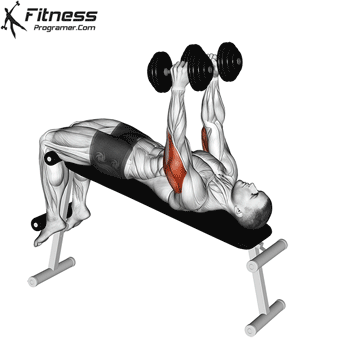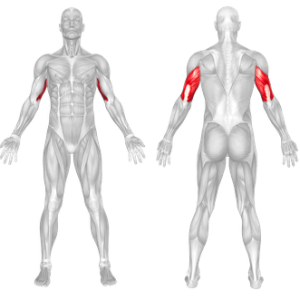Overview
The Decline Dumbbell Triceps Extension is a single-joint isolation exercise that primarily targets the triceps brachii, the large muscle on the back of the upper arm. This position changes the line of resistance and increases the stretch on the triceps, enhancing muscle activation and growth. It’s a powerful choice for individuals looking to intensify their arm training and develop fuller triceps.
How to Perform the Decline Dumbbell Triceps Extension

Setup
Lie down on a decline bench with your feet secured under the foot pads.
Hold a dumbbell in each hand with a neutral grip (palms facing each other).
Extend your arms fully above your chest with a slight bend at the elbows.
Execution
While keeping your upper arms perpendicular to the floor, bend your elbows slowly to lower the dumbbells toward the sides of your head.
Keep your elbows fixed in place and do not let them flare outward.
Lower until you feel a deep stretch in the triceps.
Reverse the movement by extending your elbows and pressing the dumbbells back up to the starting position.
Repeat for your desired number of repetitions.
Reps and Sets
Beginners: 3 sets of 8–10 reps
Intermediate to Advanced: 3 to 4 sets of 10–15 reps
Tips for Proper Form
Maintain control throughout the movement—avoid using momentum.
Ensure the dumbbells move in a straight path over your shoulders.
Keep your shoulders and upper arms stationary throughout.
Use a moderate weight to maintain form and avoid elbow strain.
Always warm up your elbows and shoulders before starting heavy sets.
Common Mistakes
Allowing the elbows to drift outward, which reduces triceps isolation.
Using excessive weight, leading to poor control and potential injury.
Cutting the range of motion short, which limits stretch and muscle activation.
Arching the back or moving the shoulders excessively during the lift.
Holding the dumbbells unevenly, which can shift tension to other muscles.
Benefits of the Decline Dumbbell Triceps Extension
1. Greater Triceps Activation
The decline angle stretches the long head of the triceps more than flat or incline positions, increasing muscle activation.
2. Enhanced Range of Motion
Lying in a decline position allows a deeper elbow bend, maximizing the stretch and contraction phases.
3. Minimal Shoulder Involvement
Because of the body position, the shoulders are less engaged, allowing the triceps to take on most of the workload.
4. Increased Muscle Growth Potential
The increased stretch and focused tension help build thicker and stronger triceps, especially when used consistently in a program.
5. Great Variation for Plateau Busting
Changing the angle of resistance helps stimulate new growth if your progress has stalled with traditional triceps exercises.
Muscles Worked

